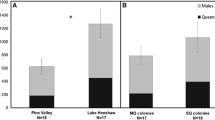Summary
Social group viability results from a trade-off between cooperation and conflict, driven respectively by group and individual interests. Workers of the slave-making ants are known to have a high egg-laying potential, leading to a potential conflict over male production. Queenright and queenless nests of the slave-making ant Protomognathus americanus show a near-linear dominance hierarchy, and dominance rank is correlated with reproductive activity. Genetic and behavioural analysis revealed that the queen, when present in the nest, is behaviourally dominant and monopolises reproduction. In queenless nests, the haploid (male) brood is produced primarily by a single worker. We suggest the dominance hierarchy regulates male production, between the queen and her workers as well as among workers. Comparison of our results to another study allows us to place our data in an ecological context. This slave-making ant species appears to fit the concession model of reproductive skew: where resources (i.e. host nests) are poor, there is strong skew and where resources are richer reproduction is more egalitarian.
Similar content being viewed by others
Author information
Authors and Affiliations
Corresponding author
Additional information
Received 31 July 2003; revised 7 October 2003; accepted 9 October 2003.
Rights and permissions
About this article
Cite this article
Blatrix, R., Herbers, J.M. Intracolonial conflict in the slave-making ant Protomognathus americanus: dominance hierarchies and individual reproductive success. Insect. Soc. 51, 131–138 (2004). https://doi.org/10.1007/s00040-003-0710-4
Issue Date:
DOI: https://doi.org/10.1007/s00040-003-0710-4




